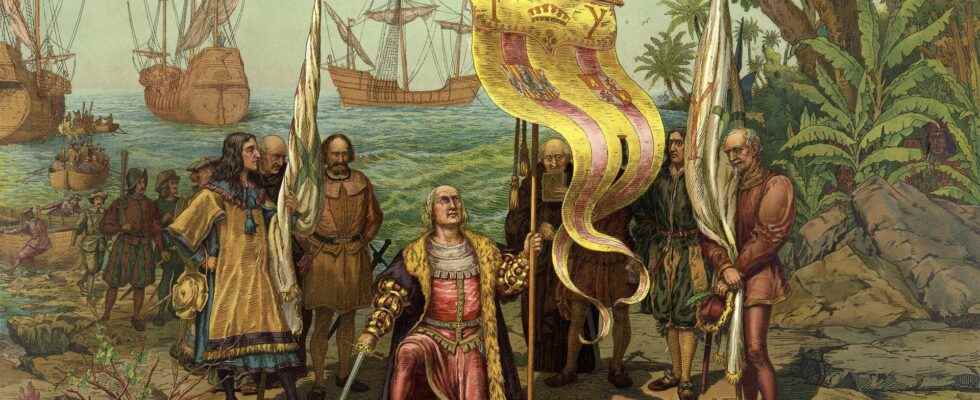The great discoveries refer to the numerous expeditions of European explorers during the Renaissance. Portuguese and Spanish navigators set out to discover new continents and open up new trade routes.
You will also be interested
The browsers Portuguese were the first to explore the Atlantic in the XVand century, descending towards the African coasts: the land routes towards the East which were taken by Marco Polo in the XIIIand century have become very uncertain since the capture of Constantinople by the Turks in 1453. The first idea is to circumvent Africa to reach India and China, then will come the more audacious one of Christopher Colombuswhich consists of taking the sea route from the west.
The Portuguese advance
In the 1420s, Portugal embarked on a real naval policy with the recruitment of geographers and construction of a new type of boat: the caravel. The Azores were discovered in 1427, Cape Verde and the Senegal River were reached in 1444. Bartolomeu Dias crossed the Cape of Good Hope in January 1488 and thus opened the sea route to India, reached by Vasco da Gama in May 1498 , when it landed on the west coast near Calicut and Goa. The Portuguese will multiply the explorations to weave a network between the Cape of Good Hope and the African stopovers of Mozambique, Zanzibar, Mogadishu, towards the Red Sea and the Persian Gulf. Navigator Afonso de Albuquerque captured Malacca in 1511, controlling the passage between Sumatra and Malaysia. The sea route to the spice islands, the Moluccas, is open: from 1512, Portugal imposes an undisputed commercial monopoly there until the arrival of the Dutch at the beginning of the 17th century.and century. In 1516, the Portuguese inaugurated the first European trading post in China, at Macau.
The Spanish competition
In 1492, the Genoese navigator Christopher Columbus convinced the Queen of Castile to finance his plan to reach the Indies from the west, believing that the shortest route between Spain and Asia was through the Atlantic. The departure from the Canary Islands took place on August 31, 1492: the three caravels of the expedition reached the Bahamas on October 11 and then Cuba the following days. Three other transatlantic voyages will allow Columbus to map the Greater and Lesser Antilles but above all to set up the process of colonization, fatal for the Native Americans. Christopher Columbus never wanted to admit the discovery of a new continent: until his death in 1506, he maintained that he set foot on a territorial advance in Asia. The name “America” appears in 1507, on a map of the world printed in Saint-Dié in the Vosges: the geographer Waldseemüller baptizes the “New World” with the first name of the navigator Amerigo Vespucci.
Sharing the world
The Portuguese and Spanish conquests required arbitration by the Pope to avoid any dispute relating to their territorial sovereignty: it was the Treaty of Tordesillas of June 7, 1494, which fixed a meridian of separation between Spanish and Portuguese domains, 370 leagues west of Cape Verde. All the lands west of this meridian belong to Spain, to the east to Portugal.
In 1500, Portugal acquired Brazil (which is located in the Portuguese zone fixed by the treaty) thanks to the navigator Pedro Álvares Cabral who had strongly deviated from his trajectory while trying to reach the Cape of Good Hope.
In August 1519, Ferdinand of Magellan leaves Seville with five ships, with the aim of reaching the Spice Islands from the west, which involves the fleet he commands in a circumnavigation of the world which was not the initial project. It circumvents South America by the strait which door henceforth its name and crosses the Pacific. In March 1521, he discovered thearchipelago of the Philippines (named in honor of Philip, the son of Charles V) before being assassinated. His expedition carried out the first circumnavigation of the world: a single ship (the Victoria) returned to Spain in September 1522.
In 1529, the Treaty of Zaragoza fixed the dividing line of Spanish and Portuguese possessions, between the Indian Ocean and the Pacific: Portugal renounced the Philippines but kept all the territories conquered since the arrival of Vasco de Gama in India.
To note
The sea route to Asia, passing through North America, remains to be discovered: this is the subject of Giovanni da Verrazzano’s voyage in 1524, commissioned by King Francis Ier. The Florentine explorer travels the American east coast to Newfoundland and finds that the American continent is indeed a barrier between Europe and Asia. He baptized North America, “Nova Gallia”, in the name of the King of France.
Interested in what you just read?
